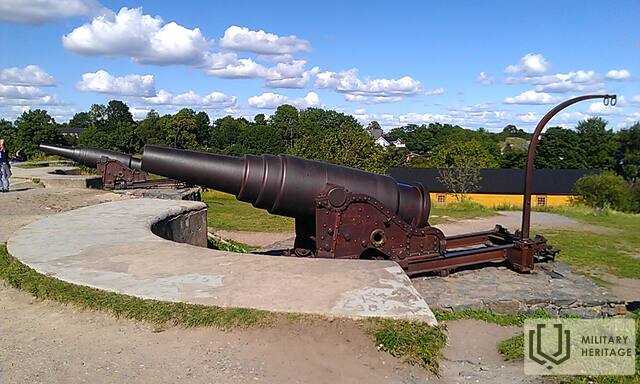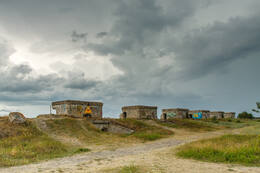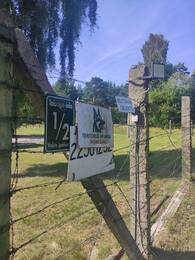Apie Liepojos tvirtovės patrankas

Šiaurinėje tvirtovės dalyje buvo viena iš keturių pakrantės gynybos baterijų – 1-oji baterija, tačiau tvirtovės likvidavimo metu jos ginkluotė nebuvo pilnai sumontuota.
Šiaurinėje tvirtovės dalyje stovėjo viena iš keturių pastatytų pakrantės gynybos baterijų – 1-oji baterija. Baterijoje buvo numatyta laikyti šešis 6 colių (152 mm) 1892 m. modelio „Canet“ sistemos pabūklus, šešis 11 colių (280 mm) 1887 m. modelio pabūklus ir du 57 mm „Nordenfeld“ priešlėktuvinius pabūklus. Tik „Canet“ sistemos pabūklai turėjo pakankamai ilgą šaudymo nuotolį, kad atlaikytų galimą Vokietijos karinio jūrų laivyno ugnį. Todėl, likviduojant tvirtovę, ginkluotė buvo sumontuota tik iš dalies.
Susijusi laiko juosta
Susijusios temos
Susijusios vietos
Liepojos šiaurinis fortas ir 1-oji baterija Karostoje
Šiauriniai fortai yra geriausiai žinoma ir vizualiai įspūdingiausia Liepojos tvirtovės dalis. Juos XIX a. pabaigoje pastatė Rusijos caro armija, o istorinis jų pavadinimas – 1-oji tvirtovės baterija.
1908 m. lapkritį, praėjus mažiau nei 10 metų po Liepojos tvirtovės pastatymo, ji nustojo veikti, nes jos statyba buvo pripažinta strategine klaida. Dalis patrankų buvo išardytos ir išvežtos į Kauno tvirtovę Lietuvoje, o kitos – išlydytos. Fortifikaciniai statiniai buvo du kartus susprogdinti, siekiant sunaikinti įtvirtinimus. Iki šių dienų išlikusios detalės yra sprogimų metu nevisiškai sunaikintos artilerijos baterijos ir požeminiai statiniai. Kaip ir Karosta, Šiauriniai fortai sovietų okupacijos metu buvo uždara karinė teritorija. Šiaurinių fortų lankytojai turėtų būti labai atsargūs. Kaip ir kitose Latvijos pakrantės vietose, status Baltijos jūros krantas Karostoje yra pavojingas dėl galimų pakrantės nuošliaužų. Todėl po fortų griuvėsiais vaikščioti draudžiama.
Šiaurinėje tvirtovės dalyje buvo įsikūrusi viena iš keturių pakrantės gynybos baterijų – 1-oji baterija. Baterijoje turėjo būti šešios 6 colių (152 mm) 1892 m. modelio „Canet“ sistemos patrankos, šešios 11 colių (280 mm) 1887 m. modelio patrankos ir dvi 57 mm „Nordenfeld“ priešlaivinės patrankos. Tik „Canet“ sistemos patrankos turėjo pakankamai ilgą šaudymo nuotolį, kad atlaikytų galimą Vokietijos karinio jūrų laivyno apšaudymą. Taigi, likviduojant tvirtovę, ginkluotė buvo sumontuota tik iš dalies.
Liepojos pakrantės artilerijos baterija Nr.2
Tarp daugelio Liepojos jūrų muziejaus eksponatų, Liepojos pakrantės artilerijos baterija Nr. 2 iki šiol yra paslaptingiausia vieta Liepojoje. Antrojoje baterijoje visada buvo įrengti įvairių valstybių karių šaudmenų sandėliai.
Liepojos tvirtovės 2-oji baterija buvo pastatyta toliau nuo pakrantės ir buvo apsaugota aukšta įtvirtinimų siena. Baterija buvo ginkluota 16 11 colių (280 mm) minosvaidžių, pagamintų 1877 m. modelio. Išardžius tvirtovę, čia buvo įrengti šaudmenų sandėliai. Dėl sprogimo pavojaus teritorija 130 metų buvo uždaryta visuomenei, saugoma, tačiau dabar čia įrengta paroda apie 1-ojo Kuršo divizijos štabo veiklą 1919–1940 m., taip pat eksponuojami 1-ojo Liepojos pėstininkų pulko, 2-ojo Ventspilio pėstininkų pulko ir Kuršo artilerijos pulko fotografiniai įrodymai.









